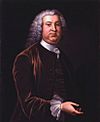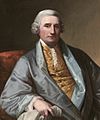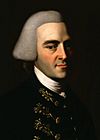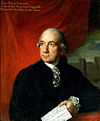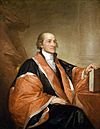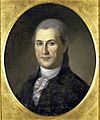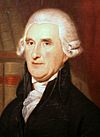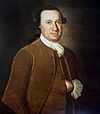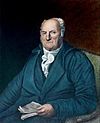President of the Continental Congress facts for kids
Quick facts for kids President of the United States in Congress Assembled |
|
|---|---|

|
|
| Continental Congress | |
| Style |
|
| Appointer | Vote within the Congress |
| Formation | September 5, 1774 |
| First holder | Peyton Randolph |
| Final holder | Cyrus Griffin |
| Abolished | November 2, 1788 |
The President of the United States in Congress Assembled was an important leader during America's early years. This person was also known as the President of the Continental Congress or the President of the Congress of the Confederation. This role was like a chairperson for the Continental Congress. The Congress was a group of representatives who met in Philadelphia. It was the first temporary national government of the United States during the American Revolution.
The president was chosen by other members of Congress. Their main job was to lead meetings and make sure discussions were fair. This position was mostly for show and didn't have much power. It was very different from the job of the President of the United States we have today.
In March 1781, the Articles of Confederation and Perpetual Union became the first constitution for the U.S. After this, the Continental Congress changed its name to the Congress of the Confederation. The same members and their president continued in their roles without stopping.
Between September 1774 and November 1788, fourteen different men served as president of Congress. They came from nine of the original 13 states. These states included Virginia, Massachusetts, Pennsylvania, South Carolina, Connecticut, Delaware, Maryland, New Jersey, and New York.
Contents
What the President Did
By design, the president of the Continental Congress had very limited power. The Congress was worried about giving too much power to one person. So, they gave their president even less responsibility than leaders in the colonial governments. For example, the president of Congress could not decide what laws to discuss. They also couldn't choose who would be on special committees. The president couldn't even meet privately with leaders from other countries. Those meetings were always held with a group of members or the whole Congress.
The president's job was mostly ceremonial. They didn't even get a salary! Their main duty was to lead the meetings of Congress. This meant being a fair leader during debates. If Congress decided to discuss important matters as a "Committee of the Whole", the president would let another member take over. Even with little power, some people worried when President Thomas McKean was also a top judge in Pennsylvania. But historians say these critics didn't understand how little power the president of Congress actually had.
The president also handled a lot of official letters. But they couldn't answer any letter unless Congress told them exactly what to say. Presidents also signed official documents from Congress, but they didn't write them. These limits could be frustrating. A delegate often lost influence when they were chosen as president.
Historian Richard B. Morris believed that some presidents still found ways to be influential. He said that without clear rules, presidents could sometimes guide events. They could help set the Congress's plans and encourage them to move in certain directions. How much influence they had depended on the person in the role.
After the Articles of Confederation were approved and the Revolutionary War ended, Congress and its presidency became less important. Fewer delegates wanted to serve in Congress. The best leaders in each state preferred to work in their state governments. It became hard for Congress to get enough members to meet. President John Hanson wanted to quit after only a week. But Congress didn't have enough members to choose a new president, so he had to stay.
President Thomas Mifflin had trouble getting states to send enough delegates. He needed them to approve the 1783 Treaty of Paris. For six weeks in 1784, President Richard Henry Lee didn't even come to Congress. He just told the secretary, Charles Thomson, to send him any papers that needed his signature.
John Hancock was chosen for a second term in November 1785. But he wasn't even in Congress at the time. Congress knew he probably wouldn't attend. He never took his seat, saying he was sick. But he might have just not been interested in the job. Two delegates, David Ramsay and Nathaniel Gorham, did his duties. They were called "chairman". When Hancock finally quit in June 1786, Gorham was elected. After Gorham resigned in November 1786, it took months for enough members to show up to elect a new president. In February 1787, General Arthur St. Clair was elected. During his time, Congress passed the Northwest Ordinance. They also chose him to be the governor of the Northwest Territory.
As people in the states discussed the new United States Constitution in late 1787, the Confederation Congress became a temporary government. There weren't enough delegates to choose St. Clair's replacement until January 22, 1788. That's when the last president of Congress, Cyrus Griffin, was elected. Griffin resigned on November 15, 1788. Only two delegates showed up for the new session of Congress.
How Long They Served
Before the Articles of Confederation were approved, presidents of Congress didn't have a set term length. Their time in office ended when they quit or when Congress chose someone new. For example, Peyton Randolph was elected in September 1774. He couldn't attend the last few days of the session because he was sick. So, Henry Middleton was chosen to replace him.
When the Second Continental Congress met the next May, Randolph was again chosen as president. But he went back to Virginia two weeks later. John Hancock was elected to fill the spot. But it was unclear if Randolph had truly resigned or was just on a break. Things got awkward when Randolph came back to Congress in September 1775. Some thought Hancock should step down, but he didn't. The problem was solved only when Randolph suddenly died that October.
The end of Hancock's term was also unclear. He left in October 1777, thinking he was just taking a long break. But when he came back, he found that Congress had elected Henry Laurens to replace him. Hancock served from May 24, 1775, to October 29, 1777. This was the longest time anyone served as president of Congress.
The length of a president's term was finally set by Article Nine of the Articles of Confederation. It said Congress could "appoint one of their number to preside." But it also said "no person be allowed to serve in the office of president more than one year in any term of three years." However, when the Articles officially started in March 1781, Congress didn't immediately elect a new president under the new rules. Instead, Samuel Huntington continued serving, even though his term was already longer than the new limit. The first president to serve the full one-year term was John Hanson (from November 5, 1781, to November 4, 1782).
List of Presidents
Here are the 14 men who served as president of the Continental Congress. The table shows their terms and backgrounds.
| Portrait | Name | State/colony | Term | Length | Previous position |
|---|---|---|---|---|---|
| Peyton Randolph (1721–1775) |
Virginia | September 5, 1774 – October 22, 1774 |
47 days | Speaker of the Virginia House of Burgesses | |
| Henry Middleton (1717–1784) |
South Carolina | October 22, 1774 – October 26, 1774 |
4 days | Speaker, S.C. Commons House of Assembly | |
| Peyton Randolph (1721–1775) |
Virginia | May 10, 1775 – May 24, 1775 |
14 days | Speaker of the Virginia House of Burgesses | |
| John Hancock (1737–1793) |
Massachusetts | May 24, 1775 – October 29, 1777 |
2 years, 158 days | President, Massachusetts Provincial Congress | |
| Henry Laurens (1724–1792) |
South Carolina | November 1, 1777 – December 9, 1778 |
1 year, 38 days | President, S.C. Provincial Congress, Vice President, S.C. | |
| John Jay (1745–1829) |
New York | December 10, 1778 – September 28, 1779 |
292 days | Chief Justice New York Supreme Court | |
| Samuel Huntington (1731–1796) |
Connecticut | September 28, 1779 – July 10, 1781 |
1 year, 285 days | Associate Judge, Connecticut Superior Court | |
| Thomas McKean (1734–1817) |
Delaware | July 10, 1781 – November 5, 1781 |
118 days | Chief Justice of the Pennsylvania Supreme Court | |
| John Hanson (1721–1783) |
Maryland | November 5, 1781 – November 4, 1782 |
364 days | Maryland House of Delegates | |
| Elias Boudinot (1740–1821) |
New Jersey | November 4, 1782 – November 3, 1783 |
364 days | Commissary of Prisoners for the Continental Army | |
| Thomas Mifflin (1744–1800) |
Pennsylvania | November 3, 1783 – June 3, 1784 |
213 days | Quartermaster General of Continental Army, Board of War | |
| Richard Henry Lee (1732–1794) |
Virginia | November 30, 1784 – November 4, 1785 |
339 days | Virginia House of Burgesses | |
| John Hancock (1737–1793) |
Massachusetts | November 23, 1785 – June 5, 1786 |
194 days | Governor of Massachusetts | |
| Nathaniel Gorham (1738–1796) |
Massachusetts | June 6, 1786 – February 2, 1787 |
241 days | Board of War | |
| Arthur St. Clair (1737–1818) |
Pennsylvania | February 2, 1787 – November 4, 1787 |
275 days | Major General, Continental Army | |
| Cyrus Griffin (1748–1810) |
Virginia | January 22, 1788 – November 2, 1788 |
298 days | Judge, Virginia Court of Appeals |
President of Congress vs. U.S. President
Even though the titles sound similar, the President of Congress was very different from the later President of the United States. As historian Edmund Burnett explained, the President of Congress was mostly a leader of meetings. They had almost no power to run the government or make decisions. On the other hand, the President of the United States is mainly an executive officer. This means they are in charge of carrying out laws. They don't lead meetings at all. So, besides having the same title, the two jobs were not alike.
Sometimes, people claim that the presidents of the Continental Congress were presidents before George Washington. But this isn't quite right because the jobs were so different. Because the Continental Congress and the Congress under the Articles continued without a break, there are different ideas about who was the "first president of the United States."
Some people say it was Peyton Randolph, who led the First Continental Congress. Others point to John Hancock, who was president when the Declaration of Independence was signed. Samuel Huntington was president when the Articles of Confederation were approved. Thomas McKean was the first president elected under the Articles. And John Hanson was the first president under the Articles to serve the full one-year term. Hanson's grandson worked hard to have Hanson recognized as the "first president of the United States." This led to Hanson's statue being placed in Statuary Hall in the U.S. Capitol. Even so, some historians say Hanson wasn't one of Maryland's most important leaders during the Revolution. Because of this effort, Hanson is often incorrectly listed as the first president of Congress under the Articles.
The role of the President of the Continental Congress is actually more like the Vice President's job today. The Vice President leads the United States Senate.
The President's Seal
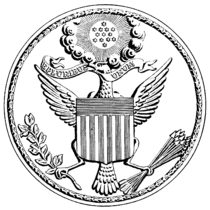
Soon after the first design for the Great Seal of the United States was made, the Congress of the Confederation ordered a smaller seal. This was for the President of the Congress to use. It was a small oval shape. In the middle, it had the crest from the Great Seal. This crest showed a bright group of thirteen stars surrounded by clouds. Above it was the motto E Pluribus Unum, which means "Out of many, one."
Historian Benson Lossing said that all presidents of Congress used this seal after 1782. They probably used it to seal envelopes for letters sent to Congress. However, only examples from Thomas Mifflin are clearly documented. This special seal was not used by the new government that started in 1789.
See also
 In Spanish: Presidente del Congreso Continental para niños
In Spanish: Presidente del Congreso Continental para niños


